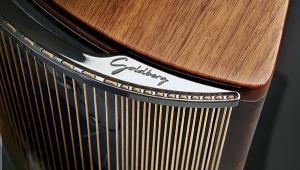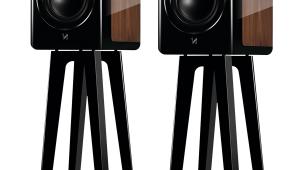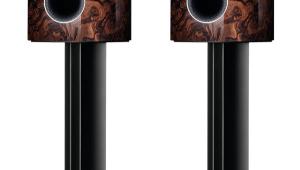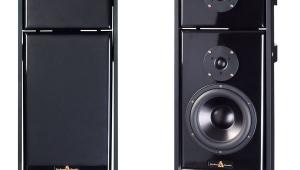Tannoy Revolution Signature Dc6 T (£1000)
The latest range from Tannoy is the new Revolution Signature series, a comprehensive line of speakers that can be configured to make up a full AV system, minus an active sub. Alternatively the front pairs alone can be used separately in a high-quality two-channel system.
Under scrutiny here is the DC6 T, an elegant three-way floorstander, employing twin six-inch woofers with edgewound coils. A pair will cost you £1000 in either of the light oak or espresso finishes available. The top unit has a 25mm titanium tweeter dome with a ‘tulip’ waveguide in a dual-concentric configuration, and all drive units are shielded to prevent their interference with traditional-style CRT TVs.
Common to the rest of the range, the DC6 T offers a number of novel solutions to some age-old problems. First up is the grille frame fixing; held in place here by magnets hidden under the veneered front baffle and within the grille frame itself, a particularly neat and well-executed solution. Next up, cabinet coloration and internal standing wave issues are dealt with by the contoured, trapezoidal cabinet and choice of cabinet materials. Tannoy’s proprietary constant directivity Dual Concentric drive unit is called up for service and there’s an option for driver earthing.
SENSITIVE SOUNDS
Wired in to my resident system – Voyd Valdi/SME 309/Audio Note IQ3, Exposure 2010 CD player, Audio Note M3 preamp, and Audio Innovations Second Audio monoblocks – the DC6 Ts were given a four-day burn-in before the time came to spin some coasters. At kick-off time, what better than The Eagles’ Greatest Hits [Asylum 7559-60511-2] for some aural stimulation?
From track one, ‘Take It Easy’, the first thing to grab me was the level as these Tannoys are considerably more sensitive than my Snells – no mean feat. Admittedly the bass is not as extended, but in relation to the cabinet volume, overall sensitivity is impressive. So what of the bass? Bass lines were taut and kept good time, sitting just in front of the drum kit, offering a robust platform for the mid and vocals.
Here we move to what I believe is this speaker’s forté, the midrange and in particular its handling of dynamics. Guitar riffs, soaring vocals and cymbal crashes sounded totally free of any compression, effectively stopping and starting on a sixpence, the high sensitivity adding a welcome dimension to the overall musical message. And, thanks to the constant directivity of the Dual Concentric tweeter, vocals appeared with a rock-solid central image. The Tannoys did not dig particularly deep in terms of detail, preferring to play more on its sensitivity card. That’s to say that it preferred to sacrifice some detail rather than dissect recordings in a forensic manner. Presentation of the mid was in character with the bass, that is, verging on the dry side. While the perspective of depth was considered reasonable, the overall sense of ‘acoustic’ was slightly lacking, resulting in a flatter soundstage presentation than one would have expected. Removing the grilles helped alleviate this, as did the connection of the separate drive unit earthing terminal.
MIDRANGE MARRIAGE
Following a close second to the dynamics was the top, or high frequency, performance. Initially the top appeared to be lacking, certainly in terms of space and air, as with the mid. However, after listening for it, it was there, superbly integrated and married to the mid in a seemingly seamless fashion. It’s difficult to imagine a conventional dome tweeter keeping up with the pace and speed of the rest of the system, not to mention the additional benefit of imaging and depth. Spurred on by such a dynamic performance, it was time for some classic rock in the form of UFO’s Obsession [Chrysalis 07243 5 21310 2 0], with ‘Pack It Up and Go’.
The drum kick intro was dry and tight with a great sense of energy, and the hi-hats had a rewarding sheen. Phil Mogg’s vocals showed good phrasing and, surprisingly, the limitations in his range as he struggled to keep up with Schenker’s acrobatics on lead guitar. This track certainly blew out the cobwebs and the Tannoys were more than up to it. A rock solid image, thanks to the excellent dispersion, enabled the Tannoys to drive the room to high levels, while staying in control where lesser speakers would fall apart.
CLASSICAL SENSIBILITIES
So much for the rock scene: it was time for some classical to check out the timbral accuracy of the DC6 Ts, so on went Strauss’ Death and Transfiguration [DG 439 467-2]. The intro built softly with tympani and strings interplaying and I must admit that after the rock ’n’ roll presentation I was expecting something ‘full-on’. Instead I was pleasantly surprised by the delicacy of the strings and sweetness of tone from the violins. The ebb and flow of the orchestra was easily captured and portrayed by the Tannoys. Indeed they seemed even better suited to classical than rock and pop. In this instance the dynamic capabilities of the Tannoys, coupled with the lack of any high-frequency irregularities, resulted in a first-rate performance.
Suitably inspired, in went Tchaikovsky’s Symphony 4 in F minor Op.36 [Oslo Philharmonic Orchestra, CHAN 8316]. This is a delightful rendition, dramatic, powerful and challenging. In the first movement the trumpets blare out, the tympani crashes, demanding your attention, not in an aggressive manner, more like a communication direct from Tchaikovsky’s compositional pen. Yet again the ability of the Tannoys to present such dynamics and stay in control impressed, and the design’s synergy with classical programme easily surpassed that of the rock genre.
VERDICT
The DC6 T delivers an exuberant performance that is excellent on rock and pop, and simply outstanding on classical. Key to this is its formidable dynamic capability, attributed to the dual-concentric drive unit dispersion and cabinet profile/construction. Add into the mix remarkable integration and the result is one of the most coherent speakers available at the price.

















































